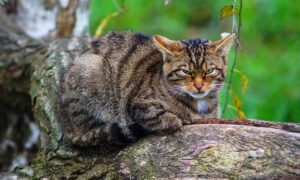After nearly 50 years, the okapi – the closest known relative to the giraffe – has been rediscovered in Virunga National Park in eastern Democratic Republic of Congo (DRC).

The okapi, can be found in zoos across the world, but hasn’t been seen in the wild for 47 years. The rediscovery is fantastic news, but the WWF (World Wildlife Fund) has urged the DRC government to take appropriate measures to ensure the long-term protection and conservation of the Virunga National Park. Otherwise, the okapi’s return to the area may be short-lived.
What is the okapi?
The okapi (Okapia johnstoni) is an unusual mammal of the Ituri Rainforest in central Africa. Although it bears striped markings reminiscent of the zebra, it is the only living close relative of the giraffe. The resemblance it bears to both the zebra and giraffe led some to believe it is a cross between the two, but despite the appearance of certain similarities, it is in fact not closely related to the zebra. Native just to the Ituri forests situated in the north east of the Democratic Republic of the Congo, it was known only to the local people until 1901.
Okapis have dark bodies, with striking horizontal white stripes on the back legs, making them resemble zebras from a distance. These markings are thought to be “follow me” markings intended to help young follow their mothers through the dense rain forest, and also serve as camouflage. The body shape is similar to that of the giraffe, except that okapis have much shorter necks. Both species have very long (apx. 30 cm or 12 inch), flexible, blue tongues that they use to strip leaves and buds from trees. The tongue of an okapi is long enough for the animal to wash its eyelids and clean its ears: it is one of the few mammals that can lick its own ears. Male okapis have short, skin-covered horns. They have large ears which help them detect their predator, the leopard.
Okapis are 7 to 8 ft (2 to 2.5 m) long, and 5 to 6 ft (1.5 to 2 m) high at the shoulder. Their weight ranges from 465 to 550 lb (200 to 250 kg).
In addition to tree leaves and buds, okapis eat grass, ferns, fruit, and fungi.
Okapis are largely nocturnal and essentially solitary, coming together only to breed. Only one infant is born at a time, between August and October, weighing between 30 and 65 lb (14-30 kg), after a gestation period of from 421 to 457 days. The young are nursed for up to ten months, and reach maturity at between four and five years of age. Their life span in captivity is over 30 years.
Okapis are unusual in their ability to sleep for only 5 minutes in a 24 hour period and remain at peak alertness.
Okapis have several methods of communicating their territory, including scent glands on each foot that leave behind a tar-like substance that signals their passage and urine marking. Males are protective of their territory, but allow females to pass through their domain for forage.
Okapis are not classified as endangered, but are threatened by habitat destruction and poaching. Conservation work in the Congo includes the continuing study of okapi behavior, and has led to the creation in 1992 of the Okapi Wildlife Reserve. The Congo Civil War threatened both the wildlife and the conservation workers in the Reserve. On June 8, 2006, scientists reported that evidence of surviving okapis in Congo’s Virunga National Park were discovered.
– Source, Wikipedia
Related Links:
Giraffe’s relative rediscovered in eastern Congo
Rare giraffe-like animal spotted
UNESCO Okapi Wildlife Reserve












